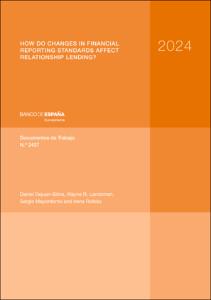How do changes in financial reporting standards affect relationship lending?
Authors
Issue Date
22-Oct-2024
Physical description
51 p.
Abstract
En este documento se examina el efecto sobre el crédito relacional en España de la implementación, en enero de 2018, del modelo de pérdida crediticia esperada según las Normas Internacionales de Información Financiera (NIIF-9). Los resultados obtenidos muestran que la relación de exclusividad entre un banco y una empresa, definida como aquella existente cuando la mayor parte del crédito de una empresa es concedido por un determinado banco, tiene un efecto positivo en el crecimiento del crédito. Sin embargo, este efecto positivo se reduce significativamente tras la implementación de NIIF-9. Se estima que el impacto negativo asociado a esta norma contable sobre el crédito relacional ha conducido a una reducción del saldo vivo de los préstamos concedidos a las empresas no financieras españolas del 2,8 %. Un análisis adicional, que restringe la muestra a empresas cuya totalidad del crédito se podría clasificar en la etapa 1 de acuerdo con la norma contable, ilustra que el impacto negativo de la nueva regulación sobre los préstamos relacionales se observa para las empresas con una mayor probabilidad de impago de su deuda bancaria y cuya calidad crediticia se ha deteriorado de manera significativa. Estos resultados son coherentes con un cambio en los incentivos que sustentan el crédito basado en las relaciones banco-cliente.
This paper analyses the effect of the expected credit loss model under IFRS 9 on relationship lending in Spain. We document that relationship exclusivity between a bank and a firm has a positive effect on the growth of credit. However, this positive effect is significantly reduced after implementation of IFRS 9. We estimate that in 2018 the negative impact of IFRS 9 on relationship lending led to a reduction in credit to Spanish non-financial firms of 2.8% of their total outstanding credit, suggesting a sizeable effect on the availability of credit. For borrowers with Stage 1 loans, we show that the new regulation has a negative impact on relationship lending at firms with a higher probability of default and whose credit quality has deteriorated. Our findings are consistent with a change in the incentives that underpin relationship lending.
This paper analyses the effect of the expected credit loss model under IFRS 9 on relationship lending in Spain. We document that relationship exclusivity between a bank and a firm has a positive effect on the growth of credit. However, this positive effect is significantly reduced after implementation of IFRS 9. We estimate that in 2018 the negative impact of IFRS 9 on relationship lending led to a reduction in credit to Spanish non-financial firms of 2.8% of their total outstanding credit, suggesting a sizeable effect on the availability of credit. For borrowers with Stage 1 loans, we show that the new regulation has a negative impact on relationship lending at firms with a higher probability of default and whose credit quality has deteriorated. Our findings are consistent with a change in the incentives that underpin relationship lending.
Publish on
Documentos de Trabajo / Banco de España, 2437
Subjects
Crédito relacional; NIIF-9; Crédito; Probabilidad de impago; Relationship lending; IFRS 9; Credit; Probability of default; Riesgo de crédito; Normativa contable; España
Appears in Collections:












